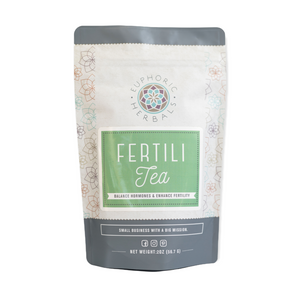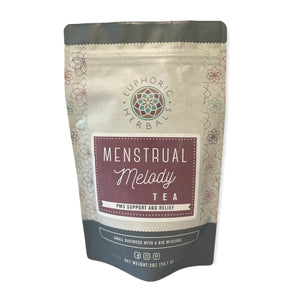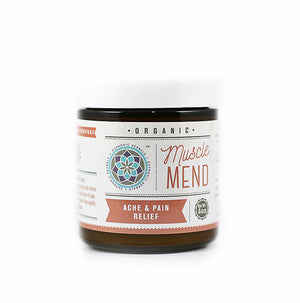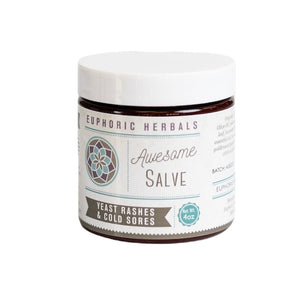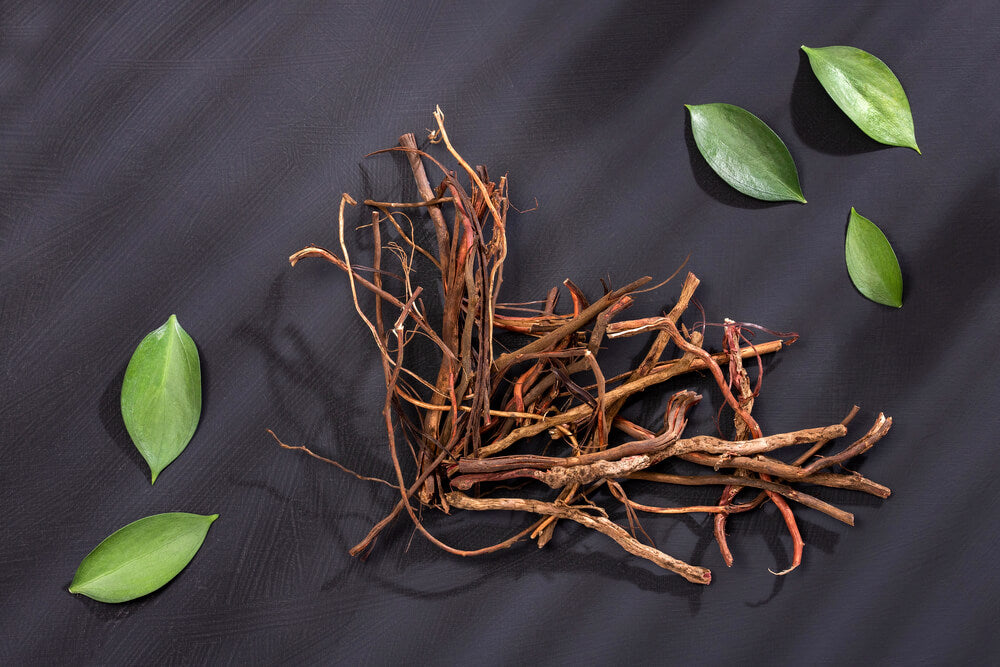Sarsaparilla is an under-utilized herb that has been used for thousands of years by indigenous people groups and has featured in various traditions, like Ayurvedic medicine and European medicine during the Dark Ages.
The roots of the plants can be used to make a tea or tincture with powerful properties for detox, skin health, and hormone balance.
Here's more about the benefits of sarsaparilla and the two different types you'll find in herbal stores.
What is Sarsaparilla? A Tale of Two Roots
True sarsaparilla goes by the botanical name of Smilax. There are several different species that can mostly be used interchangeably. The most common is Smilax ornata (formerly S. regelii).
This type of sarsaparilla is native to Central and South America as well as the Caribbean. In fact, S. ornata often goes by the common name of 'Jamaican sarsaparilla.'
Sarsaparilla plants are climbing, woody vines that belong to the lily family. They produce glossy leaves and red berries, but it's the roots that are harvested for medicinal use.
You may be familiar with sarsaparilla as an old-time drink and a traditional component of root beer. Interestingly, the root was mainly used to add foam to the beverages. Most of the flavor was supplied by sassafras.
There's also another type of sarsaparilla known as Indian sarsaparilla or Anantamul. It goes by the botanical name of Hemidesmus indicus and is not related to true sarsaparilla. The plants grow natively in South Asia and typically twine along the ground.
Surprisingly, both types of sarsaparilla have very similar benefits, in spite of the fact that they unrelated and contain different plant compounds. The roots are used in both instances and for similar purposes.
Here's a closer look at each herb, starting with true sarsaparilla root.
Benefits of Sarsaparilla (Smilax spp.)
Detoxifying

There are many great herbs for detox, but most people don't know about sarsaparilla.
The root contains powerful antioxidants and plant compounds that have a cleansing effect on your whole body, particularly your liver and kidneys. With mild diuretic properties, it helps to flush out toxins via urine.
Sarsaparilla also contains compounds, called saponins, that bind to a specific group of toxins known as endotoxins and carry them out of the body. Endotoxins are chemicals present in bacterial cells that contribute to many types of diseases when released into the bloodstream. (1)(2)
As a bonus, some studies have shown that sarsaparilla root has liver-protective properties, which may help prevent damage from toxins in the liver. (3)
Combats Inflammation
The detoxifying, antioxidant power of sarsaparilla root also gives it an ability to calm inflammation in the body. Much of this can be attributed to the fact that it helps cleanse endotoxins from your system.
Not only are endotoxins common contributors to disease, they are also considered "very potent and widely spread inflammation-inducing substances." And since chronic inflammation is a culprit behind many health problems, anything you can do to get rid of it at the source is good for your body. (4)
Traditionally, sarsaparilla was used for a wide range of inflammatory issues, including arthritis and rheumatic pain.
Some early studies confirm that it has both anti-inflammatory and pain-relieving properties, which shows why it has such a long history of use for these types of conditions. (5)
Eases Psoriasis and Other Skin Issues

Psoriasis is a frustrating skin condition that involves itchy, dry patches of skin and scaly sections of rash. There's no 'cure' for this condition, but researchers did discover decades ago that there are benefits of sarsaparilla for relieving psoriasis.
The exact way sarsaparilla works is unknown, but extracts from the root were used as early as 1942 to help relieve skin lesions from psoriasis with about a 50% success rate. Research continues into the compounds found in psoriasis to see if they could be used in some form of treatment. (6)(7)
Other skin conditions like eczema, acne, and dermatitis may also benefit from sarsaparilla, in part because it cleans out toxins that may cause skin eruptions.
Though usually taken internally for skin issues, you can also try sarsaparilla topically in this Herbal PsoriaSoothe ointment.
Promotes Hormone Balance
Yet another traditional use for sarsaparilla was to promote hormone balance and sexual health.
Certain types of saponins and other compounds within the plant roots essentially function as 'plant hormones'. This doesn't make them the same as human hormones, but some experts believe the body recognizes them as similar, and this could explain the hormone-balancing effect of certain plants.
To look at it from a different angle, sarsaparilla has long been considered a nourishing herb.
It's used to help restore the adrenals and to address other issues that are associated with depletion in the body, including a lack of libido. It could be that this nourishing/restoring action is what supports proper hormone balance.
Acts as a 'Synergist' Herb
One of the unique benefits of sarsaparilla is that it acts as a 'synergist' to enhance the effects of other herbs. Or to put it more technically, it increases the bioavailability of other herbs so your body can get more out of them.
In this aspect, sarsaparilla is similar to licorice root, which is frequently used as a synergist and 'guide drug' in traditional Chinese medicine. You may want to try using it in small amounts in your herbal formulas.
Benefits of Indian Sarsaparilla

Despite being a completely different plant than true sarsaparilla, Indian sarsaparilla (Anantamul or Hemidesmus indicus) is used for similar purposes. It is a staple in Ayurvedic medicine for things like:
- Cleansing/detoxifying the blood
- Supporting kidney and urinary tract health
- Addressing skin disorders
- Balancing hormones
- Restoring libido and energy
- Promoting breast milk production
- Calming inflammation
- Supporting joints and nerves
Following Ayurvedic principles, Indian sarsaparilla is balancing for all doshas but is especially helpful for addressing excess pitta. It is considered gentle enough for all stages of health and is a good detoxifier for those who are in a depleted state, since it nourishes even while it cleanses.
Indian sarsaparilla is beneficial for both men and women alike but is particularly supportive of the female reproductive system.
How to Use Sarsaparilla
Both varieties of sarsaparilla are commonly used to make a tea by simmering the root in water. You can drink the tea several times a day, and it's especially soothing for a sore throat.
You can also take sarsaparilla in tincture form. It's available as a single-herb tincture as well as in formulas with a combination of herbs, like this Adrenal Support Extract or this Male Vitality extract.
Indian sarsaparilla (often listed as Anantamul) is commonly available in powdered form as well. The powder can be added to smoothies, taken with ghee and honey, mixed into warm milk, and so on.
Precautions
There are no known precautions with sarsaparilla. Just be sure you look at the botanical name when you buy to be sure you get the right kind. (Smilax spp. for true sarsaparilla and Hemidesmus indicus for Indian sarsaparilla.)
Indian sarsaparilla has traditionally been consumed during pregnancy, but there aren't any studies on its safety profile. You may wish to consult with a qualified herbalist before taking either type of sarsaparilla if you are pregnant or breastfeeding.
Rediscovering Sarsaparilla
The benefits of sarsaparilla have been known for hundreds of years, but unfortunately this plant has become somewhat forgotten over time. The good news is that sarsaparilla root is widely available, so you can 'rediscover' this herb yourself.
Treat yourself to either variety of sarsaparilla to discover its nourishing, detoxifying effects!
Disclaimer: This post is for informational purposes only. It does not constitute medical advice and should not be substituted for medical advice. Please consult your health care provider, herbalist, midwife, or naturopathic physician before taking herbs, supplements, etc. Here's the link to our full disclaimer.






















































